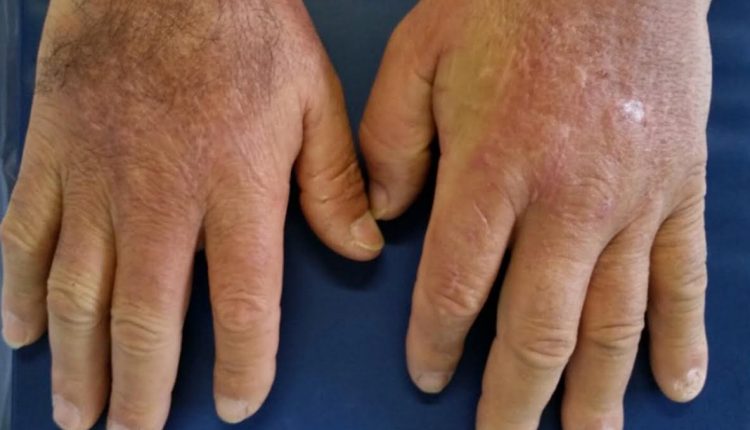
Scleroderma: causes, symptoms and treatment
Systemic sclerosis (or scleroderma) is a connective tissue disease involving the vascular system, the skin (the term scleroderma means ‘hard skin’) and the internal organs
Scleroderma most frequently affects women, especially between the ages of 30 and 50
Like all autoimmune diseases, it has a multifactorial genesis.
In ancient Greek, scleroderma literally means ‘hard skin’.
What is systemic sclerosis?
Systemic Sclerosis is a connective tissue disease involving the vascular system, the skin (the term scleroderma means ‘hard skin’) and the internal organs.
The main characteristic of the disease is the abnormal production of collagen and extra-cellular matrix that causes fibrosis of the skin, internal organs, mainly the lung, changes in the vessels and the autonomic nervous system with vasomotor changes, skin ulcers, pulmonary hypertension and dysregulation of the motility of the digestive system.
There are forms of cutaneous sclerosis without involvement of the internal organs (morphea and linear scleroderma), termed localised scleroderma, of main dermatological interest, as well as forms of cutaneous sclerosis linked to exposure to toxic substances and associated with graft versus host disease.
Scleroderma most frequently affects women, especially between 30 and 50 years of age, with a female/male ratio of 3-15:1.
The incidence is 0.9-19 new cases/million inhabitants/year.
Familial cases may occur, but more often the disease is sporadic.
What are the causes of systemic sclerosis?
Like all autoimmune diseases, Systemic Sclerosis has a multifactorial genesis: it is characterised by a dysregulation of factors regulating the birth of new vessels and the immune system, with production of specific autoantibodies, such as anti-Scl70 and anticentromere, often associated with different organ manifestations.
Anti-Scl70 are generally present in forms with diffuse skin involvement and pulmonary fibrosis, anticentromere are more frequent in forms with limited skin involvement and isolated pulmonary hypertension.
The earliest clinical manifestations are borne by the microvascular and autonomic nervous system and consist of Raynaud’s phenomenon, which is a triphasic (pallor, cyanosis, erythema) discolouration of the extremities of the hands, feet, and sometimes the nose, ear pinnae and perioral area, sometimes associated with paresthesias and skin ulcers.
What are the symptoms of systemic sclerosis?
- Skin: thickening and hardening of the skin, with claw-like retraction of the fingers, flattening of the furrows of the face (facies amimica), microcheilia, melanoderma, calcinosis.
- Autonomic nervous system: Raynaud’s phenomenon, dysmotility of the digestive tract with dyskinesias, gastro-oesophageal reflux, malabsorption syndrome, constipation, diarrhoea, faecal incontinence.
- Circulatory system: ulcers, telangiectasias, isolated pulmonary hypertension or secondary to pulmonary fibrosis.
- Pulmonary involvement: restrictive pulmonary fibrosis syndrome.
Arthralgias, arthritis, renal involvement (ranging from mild chronic renal failure to scleroderma renal crisis, i.e. rapidly progressive renal failure with malignant arterial hypertension) and cardiac involvement ranging from conduction and heart rhythm disorders to myocarditis may also be present.
Diagnosis of systemic sclerosis
The classification criteria formulated by the American College of Rheumatology in 1980 include one major criterion, cutaneous sclerosis proximal to the fingers of the hands, and either one of the major criteria or two minor criteria: sclerodactyly, pulmonary fibrosis documented on chest X-ray, skin ulcers or pitting scar.
The red flags for the early diagnosis of the disease, i.e. the particularly suspicious clinical signs identified by the European Group for the Study of Systemic Sclerosis, EUSTAR, include
- the presence of puffy hands (oedematous, chubby hands),
- the Raynaud’s phenomenon,
- the presence of anti-Scl70 or anticentromere antibodies and the scleroderma pattern, a typical alteration of the nail capillaries detected at capillaroscopy.
Patients are also classified according to skin involvement into three subsets:
- diffuse form: cutaneous sclerosis extending proximal to the elbows or knees or affecting the trunk or abdomen;
- limited form: cutaneous sclerosis distal to the elbows and knees; also includes the CREST form (cutaneous calcinosis, Raynaud’s, oesophagopathy, sclerodactyly, telangiectasia)
- sine scleroderma form: absence of cutaneous sclerosis, but presence of typical involvement of internal organs and disease-specific antibodies.
Investigations for disease diagnosis, research and staging of organ commitment include, in addition to the determination of ANA and anti-ENA autoantibodies
- capillaroscopy for scleroderma pattern (megacapillary and avascular areas);
- spirometry, DLCO, high-resolution chest CT for studying the lungs;
- Holter ECG, echocardiogram with possible right catheterisation, cardiac MRI for the study of the heart;
- oesophageal and rectal manometry, radiography and oesophagogastroduodenoscopy for the study of the digestive tract.
Treatments
Treatment of Raynaud’s phenomenon and skin ulcers is based on the use of calcium channel blocker drugs, intravenous prostanoids and the non-selective endothelin inhibitor, bosentan.
Treatment of pulmonary fibrosis involves the administration of oral or intravenous cyclophosphamide and maintenance therapy with azathioprine.
The treatment of isolated pulmonary hypertension is based on the use of selective and non-selective endothelin inhibitors, such as ambrisentan and bosentan, phosphodiesterase inhibitors, such as sildenafil and tadalafil, and prostanoids such as epoprostenol.
Experimental treatments with other immunosuppressants such as mycophenolate mofetil and with biologic drugs are under investigation.
Read Also:
Emergency Live Even More…Live: Download The New Free App Of Your Newspaper For IOS And Android
Psoriasis, An Ageless Skin Disease
Relapsing-Remitting Multiple Sclerosis (RRMS) In Children, EU Approves Teriflunomide
ALS: New Genes Responsible For Amyotrophic Lateral Sclerosis Identified
Psoriatic Arthritis: What Is It?
Rehabilitation Therapies In The Treatment Of Systemic Sclerosis
Psoriasis: It Gets Worse In Winter, But It’s Not Just The Cold That’s To Blame
Exposure To Cold And Symptoms Of Raynaud’s Syndrome
Scleroderma. Blue Hands, A Wake-Up Call: The Importance Of Early Diagnosis



